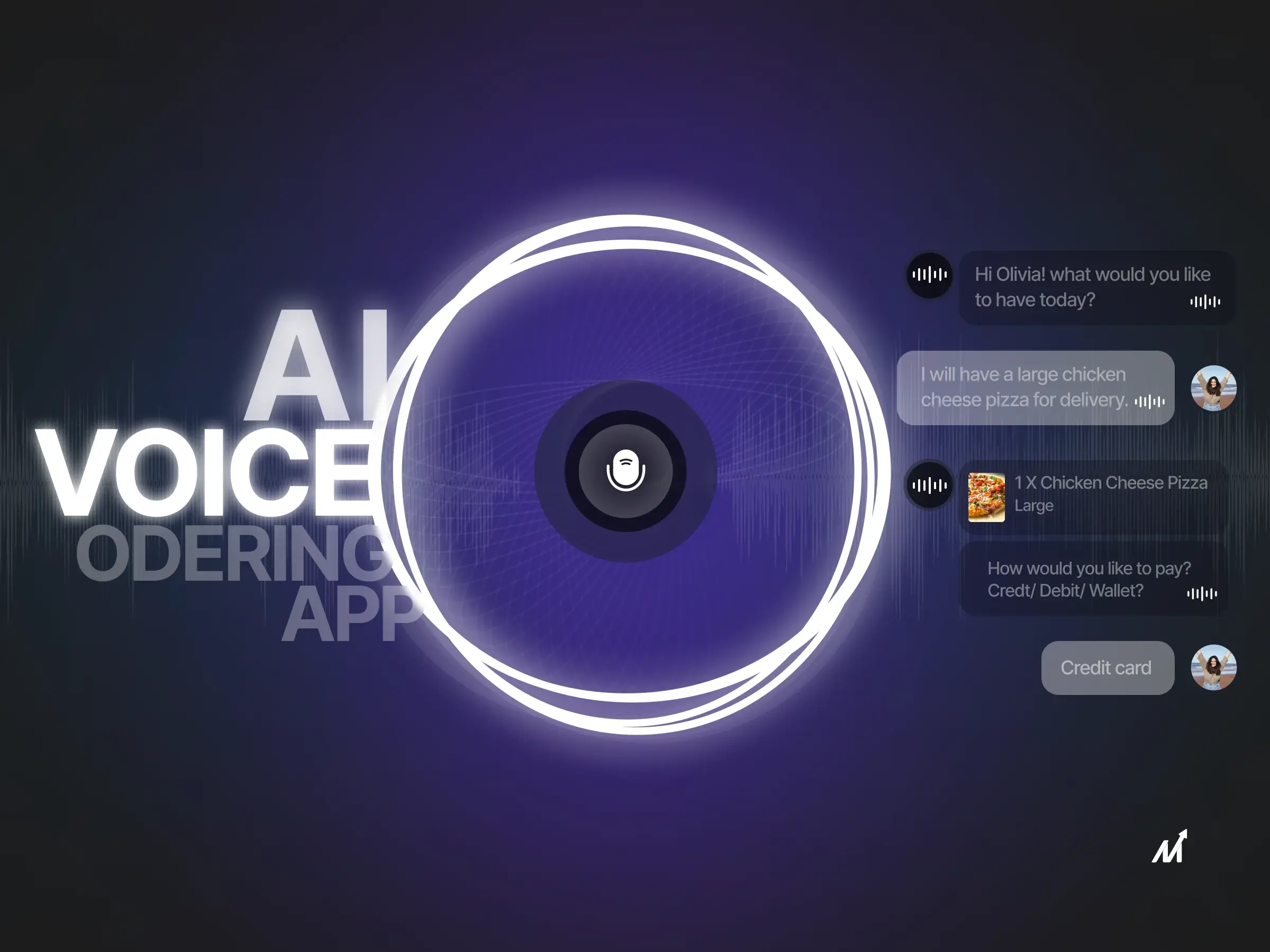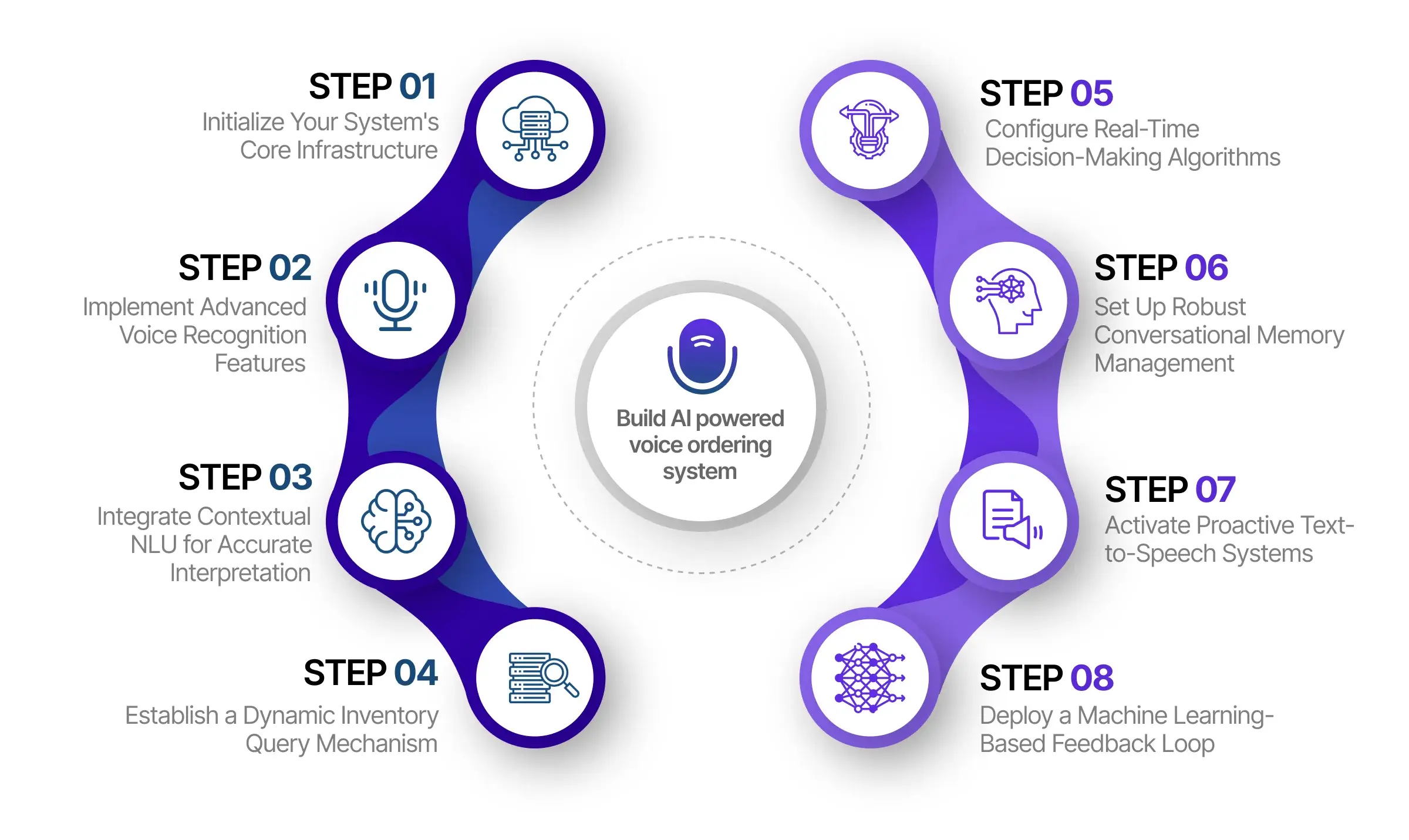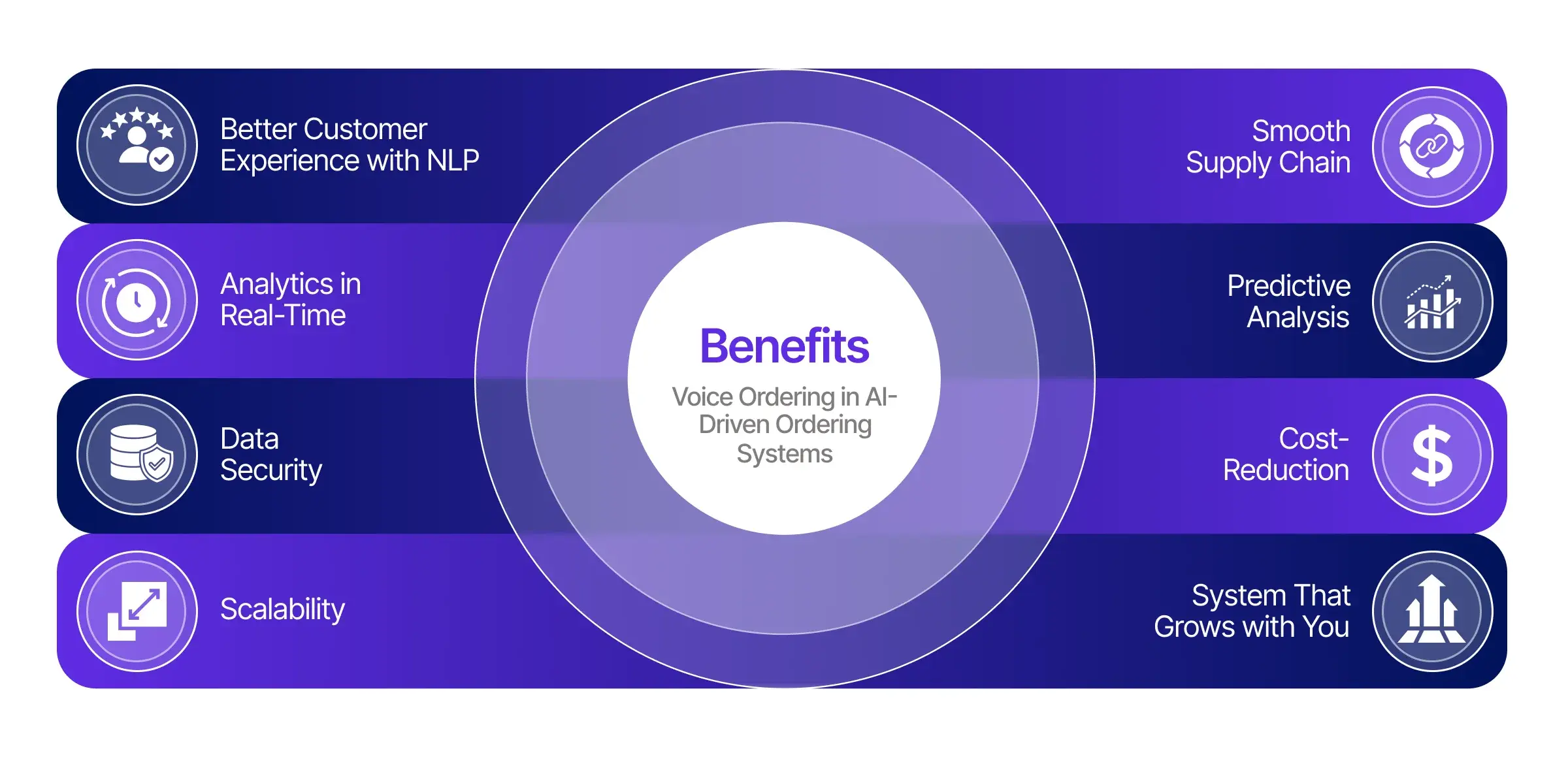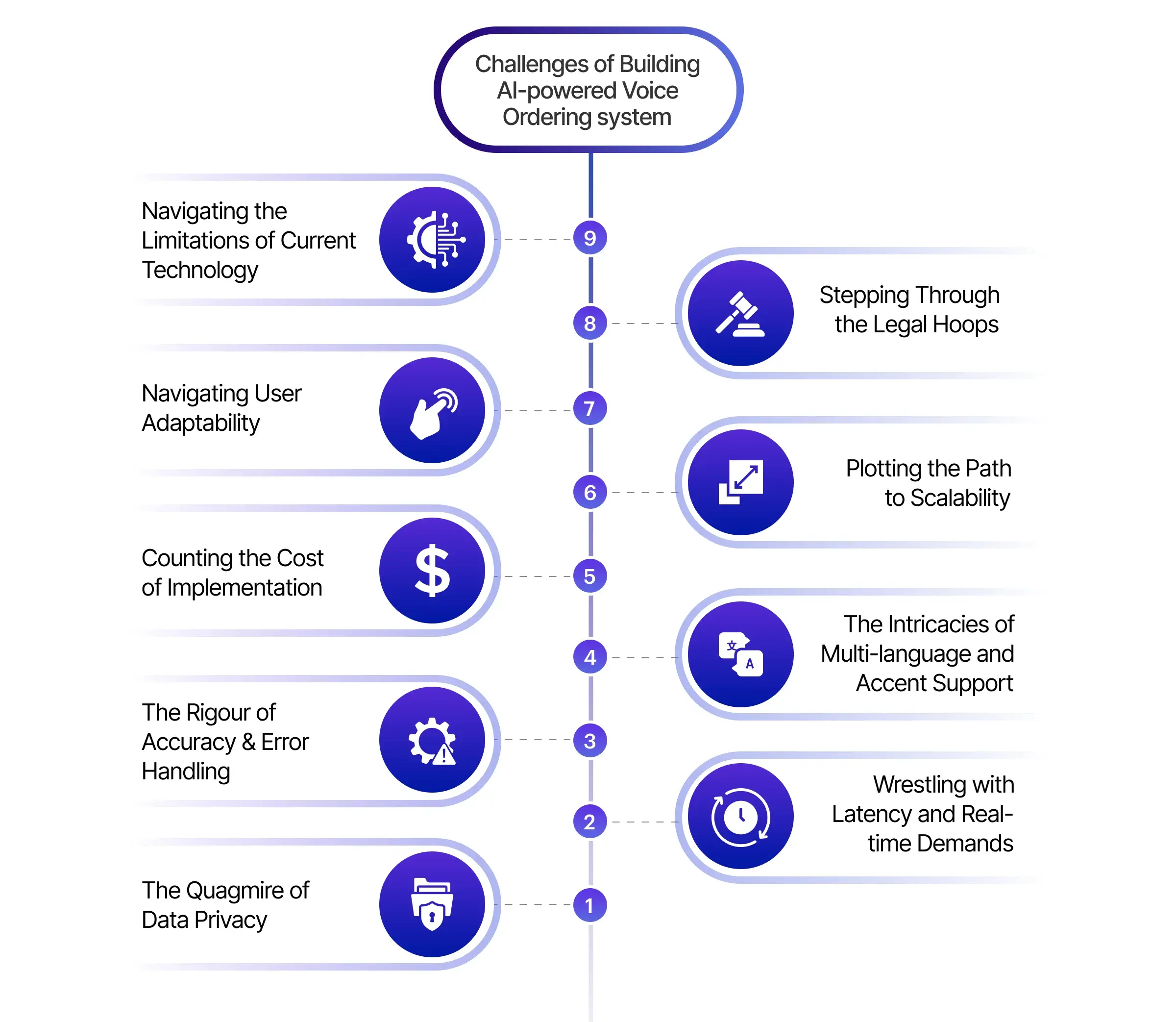AI-powered Voice Ordering applications are stepping up in the fast-paced enterprise world, where the quest for efficiency and user experience often collide. These aren’t just virtual assistants that can understand “yes” or “no”; we’re talking about sophisticated systems with a grasp of natural language, thanks to advanced Natural Language Processing. Imagine an executive on the road, toggling between client calls and emails. A quick voice command to the company’s AI ordering system could confirm new stock purchases or even execute a complex procurement strategy without glancing at a screen. This is absolute convenience backed by cutting-edge tech, including Machine Learning algorithms that continually refine system responses for accuracy.
On the security front, Voice Biometric Authentication isn’t just sci-fi vocabulary; it’s an additional layer ensuring that sensitive company data remains strictly in-house. It’s a win-win, enhancing both efficiency and user experience while maintaining high security and data integrity standards. And let’s not forget analytics. These systems don’t just take orders; they collect invaluable data and insights, making them not just a tool but a strategic asset for any forward-thinking enterprise.
How Does an AI Voice Ordering System Work?
Voice ordering systems harness a blend of Natural Language Processing (NLP), machine learning algorithms, and cloud-based computational services to facilitate a seamless interaction between humans and computers. When a customer initiates a voice AI command, a digital microphone captures the acoustic signals and converts them into digital data. This data is then forwarded to an NLP engine through a secure API call.
The NLP engine, often running on distributed cloud servers, first performs speech-to-text conversion. With the help of Convolutional Neural Networks (CNNs) or Recurrent Neural Networks (RNNs), it decomposes the audio signals into phonemes and maps them to corresponding text. The textual data undergoes syntactic and semantic parsing, leveraging algorithms like Transformer models or Long Short-Term Memory (LSTM) networks to decode the structure and intent behind the utterance.
Finally, the parsed command triggers the execution of pre-programmed tasks—like ordering a product—through backend servers connected to databases and e-commerce platforms. Upon successful completion, the system generates a text-based confirmation, which is converted back into human-audible form through text-to-speech algorithms. This is relayed to the user, confirming the success of the voice-activated transaction. Thus, the voice ordering system melds sophisticated technology layers, each serving a pivotal role in producing a unified, intuitive user experience.
How to Build an AI Voice Ordering System?
Step 1: Initialize Your System’s Core Infrastructure
Begin by procuring robust server infrastructure, ensuring it can handle high computational loads. Opt for cloud-based solutions such as AWS, Google Cloud, or Azure, or prepare an in-house server that meets the computational demands of AI algorithms. You’ll need to install a database management system like MySQL or PostgreSQL for storing order-related data. Ensure SSL encryption and take all necessary cybersecurity measures to protect sensitive customer data.
Step 2: Implement Advanced Voice Recognition Features
Your system’s ears should be built on state-of-the-art Deep Neural Networks (DNN) specifically trained on a large corpus of voice data. Consider adding a Voice Activity Detector (VAD) that identifies when the user starts and stops speaking. For enhanced performance, incorporate Beamforming algorithms that use multiple microphones to isolate the voice signal from the noise. The real magic happens when you connect this to a Recurrent Neural Network (RNN) based Speech-to-Text (STT) engine, which adds context awareness to transcriptions. The result is a more accurate and efficient interpretation of user speech.
Step 3: Integrate Contextual NLU for Accurate Interpretation
Once you obtain the transcribed text, you should pass it through a more advanced Natural Language Understanding module. This goes beyond basic NLP; NLU understands the semantics of the sentence and the context in which words are used. For this, Transformer-based models like BERT or GPT are optimal. These models can distinguish between the user asking for “hot coffee” as a beverage and using the word “hot” to express urgency.
Step 4: Establish a Dynamic Inventory Query Mechanism
Your AI engine should be capable of running dynamic SQL queries on your stock database. This is where advanced algorithms like Q-learning can come in handy. The AI can remember customer preferences and recommend products intelligently. If the customer always orders spicy food, the system could dynamically generate SQL queries to sort out spicy food options from your stock and suggest them in real time.
Step 5: Configure Real-Time Decision-Making Algorithms
To make the ordering process seamless, integrate real-time decision-making algorithms that can confirm the order instantly. Decision Trees or Random Forest algorithms can be used to determine if the credit card transaction should be authorized or if additional user validation is needed. Every node in these algorithms should correspond to a unique business logic, like stock availability, delivery options, or payment methods.
Step 6: Set Up Robust Conversational Memory Management
A Context Management System should maintain a ‘memory’ of the ongoing conversation, so if a customer interrupts the order to ask about the weather, the AI system can effortlessly switch context, provide the information, and then smoothly return to the incomplete order. This requires advanced state management algorithms that can simultaneously hold multiple conversational threads and variables.
Step 7: Activate Proactive Text-to-Speech Systems
The TTS engine should be more than a simple voice rendering tool; it should also possess Emotional Intelligence (EI) capabilities. With sentiment analysis algorithms, your TTS engine should detect the user’s mood based on the text and modulate its tone accordingly. If the text from the user shows frustration, the TTS can respond with a calming tone. Such a feature makes your AI system incredibly responsive and adaptive to real human emotions.
Step 8: Deploy a Machine Learning-Based Feedback Loop
The system should automatically review the customer’s behavior and the precision of its actions once the transaction is complete to enhance its algorithms going forward. Reinforcement learning algorithms might be used, which optimize for improved user experience and operational effectiveness by learning from each transaction.
By leveraging state-of-the-art AI technologies, you’re not merely developing a voice assistant; you’re unlocking the potential to revolutionize your customer service. These intelligent systems can engage in dynamic dialogues, adapt in real-time, and even understand user sentiments. Beyond that, they offer invaluable benefits for your business, some of which we’ve explored in detail below.
If you’re keen on adopting this transformative technology, partnering with the right experts is essential for a smooth implementation. Our team has the technical know-how to guide you through every step of building an efficient AI voice ordering system. Interested in learning more? We invite you to get in touch with us via our Contact Us page.
There could be many benefits of having an AI ordering system for your business, but here are some of the key benefits we have outlined in detail.
Benefits of Voice-powered AI Ordering System in AI-Driven Ordering Systems
1. The Magic of a Better Customer Experience with Natural Language Processing
First off, let’s talk about what matters: the users. You can’t ignore how fed up people get with endless, clunky menus. “Press 1 for this; press 9 for that.” It’s exasperating. Enter Voice AI Ordering Systems with top-notch Natural Language Processing (NLP) capabilities. This is like swapping out a pencil for a high-end tablet. Users get to simply say what they want. The system understands, processes, and voila! It’s not just ordering that gets easier; the whole experience gets a facelift. The user leaves happier, and that’s money in the bank for brand loyalty.
2. Analytics in Real-Time—The Gift That Keeps on Giving
Imagine if you had a genie that whispered invaluable business advice in your ear every day. That’s what real-time analytics feels like when paired with an AI Voice Ordering System. We’re talking data that tells you more than just numbers; it tells a story. Who’s buying what, when, and why? Get those answers in real-time, adapt your business strategies like a pro, and leave your competition playing catch-up.
3. Data Security—The Invisible Shield
Today, data is as precious as gold and just as tempting for pirates. We’re pulling out all the stops on this one. Advanced encryption algorithms act as the guardians of your user’s data. Imagine a bank vault, but one that self-upgrades its lock mechanism every day. This is peace of mind for you and trustworthiness in your customer’s eyes—a win-win situation.
4. Scalability, or How to Be Elastic and Strong
Who doesn’t want to be able to stretch and contract effortlessly? Especially businesses that see tidal waves of demand followed by quiet lulls. Cloud-based Voice Ordering Systems give you just that sort of elasticity. You can be a small boutique or a retail giant; it will fit you like a glove, ensuring you never bite off more than you can chew.
5. A Supply Chain So Smooth, It’s Almost Eerie
Usually, supply chain management is like juggling flaming torches while riding a unicycle. It’s tough! But with machine learning in the mix, the universe aligns to make your life easier. Is stock running low? The system already ordered it. A sudden surge in a particular product’s popularity? You’re prepared, and you didn’t even break a sweat.
6. Making Smart Choices with Predictive Analysis
Remember that genie analogy? It still applies, but now imagine that your genie is also an astute data scientist. Predictive analytics is at the heart of these voice-activated AI ordering systems. This technology employs statistical algorithms and machine learning techniques to analyze historical data and predict future trends. In essence, it grants your business a data-driven sixth sense. Far from magical thinking, predictive analytics leverages actionable insights, allowing you to make smart inventory choices, manage resource allocation, and even anticipate customer behaviors. All these capabilities elevate you from a mere business owner to a visionary strategist, using intelligence—not just intuition—to steer your venture.
7. Doing More with Less—The Dream Team of Efficiency and Cost-Reduction
Automation is not just a buzzword; it’s a game-changer. A Voice Ordering System can replace a battalion of customer service reps without taking a coffee break. This means you can allocate your human resources where you need a human touch, like strategic planning or quality control.
8. A System That Grows with You
Implementing an AI voice ordering system is not just about adopting a cutting-edge technology; it’s a strategic investment for long-term business growth. These systems are designed to continuously adapt and enhance their performance, ensuring that your operations remain efficient and up-to-date with the latest advancements in the field.
These are the compelling reasons why a Voice Ordering System isn’t just an upgrade; it’s a revolution for enterprises. It’s a blend of cutting-edge tech and commonsense business smarts that make your life easier, your customers happier, and your profit margins healthier. As every coin has two sides – building a reliable voice ordering system is not without challenges. Let’s understand a few of those challenges.
Challenges of Building an AI Voice Ordering System
1. The Quagmire of Data Privacy
Data privacy isn’t merely an abstract concern; it is the cornerstone of customer trust and a non-negotiable element in regulatory compliance. When it comes to AI voice ordering systems, the stakes are higher than ever. These systems collect not just transactional information, but also sensitive voice data, bringing forth a unique set of privacy challenges. Voice data can contain personal identifiers, behavioral traits, and even emotional states, amplifying the complexity of data privacy issues. As such, securing this information isn’t just about encryption; it also demands stringent access controls and robust protection against a new frontier of cyber threats targeted at voice data. An oversight in safeguarding this type of data can result in not just financial setbacks, but also irrevocable harm to a company’s credibility.
2. Wrestling with Latency and Real-time Demands
In the context of AI voice ordering systems, speed isn’t just a luxury—it’s a necessity. Users expect real-time responsiveness when interacting with voice-enabled systems. Any lag, even if it’s just a fraction of a second, can result in a frustrating user experience and diminish the system’s utility. To meet these real-time demands, the technical backend of the AI voice ordering system needs to be robust and agile.
This challenge isn’t merely theoretical; it mandates constant optimization of algorithms and a robust computational infrastructure. In the realm of AI-driven voice ordering systems, the engineering teams must continually fine-tune their machine learning algorithms and natural language processing components. This iterative refinement ensures that voice commands are not only recognized but also processed with utmost efficiency, thereby eliminating latency and meeting the high expectations users have for real-time interactions.
3. The Rigour of Accuracy and Error Handling
When deploying an AI voice ordering system, the integrity of every transaction hinges on two pivotal factors: pinpoint accuracy and effective error handling. Imagine a scenario where you’re operating in an enterprise environment: a simple command like ordering printer ink or booking a meeting room can easily turn into a significant blunder if misunderstood. Such mistakes can lead to not just operational inefficiencies but also steep financial losses or even reputational damage.
The challenge is nuanced yet clear-cut—designing an AI system that operates with unparalleled accuracy while also deploying a fail-safe error-handling protocol. In essence, the system’s architecture must be deftly engineered to include multiple layers of fallback options, redundancies, and real-time alert mechanisms. These elements work in concert to preemptively tackle any lapses, ensuring that the AI voice ordering system remains both reliable and effective.
4. The Intricacies of Multi-language and Accent Support
In a global marketplace, an AI voice ordering system must be as linguistically diverse as its user base. Far from being just an ethical consideration, linguistic support is a business imperative. To make this possible, developers need to invest in machine learning models trained on varied linguistic data.
So, what does this mean for your AI voice ordering system? It must be built to understand not just words but the cultural and linguistic nuances behind them. Only then can it serve as a truly inclusive, and therefore more competitive, business asset.
5. Counting the Cost of Implementation
The financial bottom line is a key concern when implementing a voice ordering system. Costs can include licenses, hardware, and ongoing maintenance. This makes budgetary planning and ROI calculations critical. For tailored cost estimates of an AI voice ordering system, contact us.
6. Plotting the Path to Scalability
Any technology that can’t grow with an enterprise is a bottleneck waiting to happen. A voice ordering system must be designed with both vertical and horizontal scalability in mind. This means accommodating more users or handling more complex tasks and integrating effortlessly with existing and future technologies.
7. Navigating User Adaptability
Technological brilliance is futile if the people using it are left scratching their heads. The utility and adoption of a voice ordering system are significantly influenced by its user-friendliness. Enterprises, therefore, need to factor in training programs and intuitive design aspects to bridge the human-technology gap.
8. Stepping Through the Legal Hoops
Different industries have specific regulations, be HIPAA for healthcare or stringent data management policies in finance. Ignorance isn’t bliss here; it’s a ticket to legal complications. Ensuring that the voice ordering system complies with all relevant laws is arduous but unavoidable.
9. Navigating the Limitations of Current Technology
Lastly, it’s imperative to delineate the current limitations intrinsic to AI, voice recognition, and Natural Language Processing (NLP) technologies. Despite their advancements, these systems are far from flawless. For instance, they may grapple with understanding accents or dialects, leading to inaccuracies in voice recognition. Additionally, they can struggle with context ambiguity—when a word or phrase can be interpreted in multiple ways—making it difficult for the machine to understand the user’s intent. Furthermore, they are often ill-equipped to handle conversational nuances like sarcasm or rhetorical questions. Therefore, it’s paramount to engage in a perpetual cycle of refinement and adaptation to bridge these gaps.
How Markovate Delivers Exceptional Value in AI Voice Ordering Systems?
In today’s rapidly evolving technological landscape, the need for robust, scalable, and secure voice-ordering systems is more critical than ever. At Markovate, our specialization lies in crafting bespoke AI voice systems tailored to meet your unique business needs. Leveraging our profound expertise in Natural Language Processing (NLP) and Machine Learning (ML), our team of professionals engineers solutions that not only understand human speech but also adapt and improve over time.
Security remains a paramount concern for any business, and Markovate addresses this with a holistic approach. Utilizing cutting-edge Voice Biometric Authentication, we ensure that your system is accessible only to authorized individuals. This security measure preserves the integrity of your data while allowing seamless interaction with the technology.
But our offerings extend beyond mere voice-activated command systems. We believe in empowering businesses with data-driven insights. Our AI voice-ordering systems are designed to capture and analyze real-time data, providing invaluable insights that enable you to refine your business strategies continually.
When embarking on the journey to implement an AI voice-ordering system, various challenges may arise, from scalability to data security as discussed above. Markovate rises to the occasion by meticulously planning each project to counter these challenges effectively. Our services aren’t just limited to AI voice systems; they encompass Generative AI, comprehensive AI consulting services, and much more. For a deep dive into how we can transform your business, feel free to contact us.
We understand that you may have some queries before taking the plunge into the world of AI voice-ordering systems. To facilitate your decision-making process, we’ve compiled a brief FAQ section below:
Frequently Asked Questions: How to Build an AI Ordering Application
1. What Are the Core Components for Building a Scalable AI Voice Ordering Architecture?
In the context of constructing a robust AI voice-ordering application, the architecture generally comprises several key components:
- Speech-to-Text Engine: Converts spoken language into written text. Google’s Speech-to-Text API or IBM’s Watson are examples of services that can perform this function.
- Natural Language Understanding (NLU) Module: Analyzes the converted text to derive context and intent. It leverages machine learning algorithms to understand user input semantically.
- Backend APIs: Facilitate the business logic, inventory management, and transactional capabilities. They interact with product information, pricing, and user history databases.
- Text-to-Speech Engine: Converts the processed response back into human-audible format. Amazon’s Polly could serve as a text-to-speech engine.
The components must be seamlessly integrated and optimized for scalability, ensuring the application can handle many simultaneous requests without latency issues.
2. How Can Machine Learning Models Be Trained to Handle Domain-Specific Vocabulary and Accents?
While off-the-shelf speech recognition services are highly capable, they may not be fine-tuned for industry-specific vocabulary or varying accents. To accommodate these, custom machine learning models can be trained. The training dataset should have audio samples encompassing domain-specific terminologies and multiple accents. Supervised learning techniques can then be employed to fine-tune these models, which can be integrated into the AI voice-ordering application.
3. What Security Measures Should Be Implemented to Safeguard User Data and Transactions?
Given the sensitive nature of voice ordering, which could involve processing personal information and financial transactions, implementing robust security measures is paramount. Some recommended approaches include:
-
Two-Factor Authentication: To validate the identity of the user.
-
End-to-End Encryption: To secure the data pipeline from the point of voice capture to transaction completion.
-
OAuth Tokens: For secure API calls to backend services.
-
Intrusion Detection Systems (IDS): To monitor and alert against strange activities within the application ecosystem.
4. How Can Latency and Performance Issues Be Mitigated in Real-Time Voice Processing?
Real-time voice processing necessitates a low-latency environment for an optimal user experience. Various strategies can be employed to minimize latency:
-
Edge Computing: Distributes data processing tasks closer to the data source, reducing the need for data to travel back and forth to a centralized server.
-
Parallel Computing: Involves distributing the workload across multiple processors to speed up computational tasks.
-
Optimized Algorithms: For NLU and Speech-to-Text conversions to ensure quicker data processing.
-
Caching Mechanisms: For frequent queries and commands, reducing the computational load for those operations.
By focusing on these core issues, organizations can better prepare themselves for the challenges of creating a secure, efficient, and scalable AI voice-ordering application.

Rajeev Sharma
I’m Rajeev Sharma, Co-Founder and CEO of Markovate, an innovative digital product development firm with a focus on AI and Machine Learning. With over a decade in the field, I’ve led key projects for major players like AT&T and IBM, specializing in mobile app development, UX design, and end-to-end product creation. Armed with a Bachelor’s Degree in Computer Science and Scrum Alliance certifications, I continue to drive technological excellence in today’s fast-paced digital landscape.
























Discussion about this post